MicroRNA2871b of Dongxiang Wild Rice (Oryza rufipogon Griff.) Negatively Regulates Cold and Salt Stress Tolerance in Transgenic Rice Plants
Abstract
1. Introduction
2. Results
2.1. Cold and Salt Stress Decreases miR2871b Expression
2.2. Expression of miR2871b Was Up-Regulated in Transgenic Plants
2.3. Overexpression of miR2871b in Rice Reduces Cold Tolerance
2.4. Overexpression of miR2871b in Rice Decreases Salt Tolerance
2.5. Analysis of Differentially Expressed Genes in miR2871b Overexpressing Rice Plants
2.6. Analysis of cis-Acting Elements and Target Prediction of miR2871b
3. Discussion
4. Materials and Methods
4.1. Plant Material and Stress Treatments
4.2. Plasmid Construction and Genetic Transformation
4.3. Physiological Index Determination
4.4. RNA Isolation and qRT-PCR Analysis
4.5. Transcriptome Sequencing and Bioinformatic Analysis
4.6. Putative Target Prediction and Analysis of Cis-Acting Elements
5. Conclusions
Supplementary Materials
Author Contributions
Funding
Institutional Review Board Statement
Informed Consent Statement
Data Availability Statement
Conflicts of Interest
References
- Muthayya, S.; Sugimoto, J.D.; Montgomery, S.; Maberly, G.F. An Overview of Global Rice Production, Supply, Trade, and Consumption. Ann. N. Y. Acad. Sci. 2014, 1324, 7–14. [Google Scholar] [CrossRef] [PubMed]
- Jiang, D.; Zhou, L.; Chen, W.; Ye, N.; Xia, J.; Zhuang, C. Overexpression of a MicroRNA-Targeted NAC Transcription Factor Improves Drought and Salt Tolerance in Rice via ABA-Mediated Pathways. Rice 2019, 12, 76. [Google Scholar] [CrossRef] [PubMed]
- Sita, K.; Kumar, V. Role of Gamma Amino Butyric Acid (GABA) against Abiotic Stress Tolerance in Legumes: A Review. Plant Physiol. Rep. 2020, 25, 654–663. [Google Scholar] [CrossRef]
- Cui, S.; Huang, F.; Wang, J.; Ma, X.; Cheng, Y.; Liu, J. A Proteomic Analysis of Cold Stress Responses in Rice Seedlings. Proteomics 2005, 5, 3162–3172. [Google Scholar] [CrossRef]
- Hussain, S.; Zhang, J.; Zhong, C.; Zhu, L.; Cao, X.; Yu, S.; Bohr, J.A.; Hu, J.; Jin, Q. Effects of Salt Stress on Rice Growth, Development Characteristics, and the Regulating Ways: A Review. J. Integr. Agric. 2017, 16, 2357–2374. [Google Scholar] [CrossRef]
- Yarra, R.; Wei, W. The NAC-Type Transcription Factor GmNAC20 Improves Cold, Salinity Tolerance, and Lateral Root Formation in Transgenic Rice Plants. Funct. Integr. Genom. 2021, 21, 473–487. [Google Scholar] [CrossRef]
- Xiong, L.; Zhu, J.K. Abiotic Stress Signal Transduction in Plants: Molecular and Genetic Perspectives. Physiol. Plant. 2001, 112, 152–166. [Google Scholar] [CrossRef]
- Jones-Rhoades, M.W.; Bartel, D.P.; Bartel, B. MicroRNAs and Their Regulatory Roles in Plants. Annu. Rev. Plant Biol. 2006, 57, 19–53. [Google Scholar] [CrossRef]
- Rogers, K.; Chen, X. Biogenesis, Turnover, and Mode of Action of Plant MicroRNAs. Plant Cell 2013, 25, 2383–2399. [Google Scholar] [CrossRef]
- Sunkar, R.; Chinnusamy, V.; Zhu, J.; Zhu, J.K. Small RNAs as Big Players in Plant Abiotic Stress Responses and Nutrient Deprivation. Trends Plant Sci. 2007, 12, 301–309. [Google Scholar] [CrossRef]
- Wahid, F.; Shehzad, A.; Khan, T.; Kim, Y.Y. MicroRNAs: Synthesis, Mechanism, Function, and Recent Clinical Trials. Biochim. Biophys. Acta Mol. Cell Res. 2010, 1803, 1231–1243. [Google Scholar] [CrossRef] [PubMed]
- Lindsay, M.A.; Griffiths-Jones, S.; Dalmay, T. Mechanism of miRNA-Mediated Repression of mRNA Translation. Essays Biochem. 2013, 54, 29–38. [Google Scholar] [CrossRef] [PubMed]
- Mallory, A.C.; Bouché, N. MicroRNA-Directed Regulation: To Cleave or Not to Cleave. Trends Plant Sci. 2008, 13, 359–367. [Google Scholar] [CrossRef] [PubMed]
- Barrera-Figueroa, B.E.; Gao, L.; Wu, Z.; Zhou, X.; Zhu, J.; Jin, H.; Liu, R.; Zhu, J.K. High Throughput Sequencing Reveals Novel and Abiotic Stress-Regulated MicroRNAs in the Inflorescences of Rice. BMC Plant Biol. 2012, 12, 132. [Google Scholar] [CrossRef] [PubMed]
- Gupta, O.P.; Meena, N.L.; Sharma, I.; Sharma, P. Differential Regulation of MicroRNAs in Response to Osmotic, Salt and Cold Stresses in Wheat. Mol. Biol. Rep. 2014, 41, 4623–4629. [Google Scholar] [CrossRef]
- Hu, Z.; Liu, A.; Gitau, M.M.; Huang, X.; Chen, L.; Fu, J. Insights into the MicroRNA-Regulated Response of Bermudagrass to Cold and Salt Stress. Environ. Exp. Bot. 2018, 145, 64–74. [Google Scholar] [CrossRef]
- Sun, X.; Xu, L.; Wang, Y.; Yu, R.; Zhu, X.; Luo, X.; Gong, Y.; Wang, R.; Limera, C.; Zhang, K. Identification of Novel and Salt-Responsive miRNAs to Explore miRNA-Mediated Regulatory Network of Salt Stress Response in Radish (Raphanus Sativus L.). BMC Genom. 2015, 16, 197. [Google Scholar] [CrossRef]
- Wang, B.; Sun, Y.; Song, N.; Wei, J.; Wang, X.; Feng, H.; Yin, Z.; Kang, Z. MicroRNAs Involving in Cold, Wounding and Salt Stresses in Triticum aestivum L. Plant Physiol. Biochem. 2014, 80, 90–96. [Google Scholar] [CrossRef]
- Chen, L.; Luan, Y.; Zhai, J. Sp-miR396a-5p Acts as a Stress-Responsive Genes Regulator by Conferring Tolerance to Abiotic Stresses and Susceptibility to Phytophthora nicotianae Infection in Transgenic Tobacco. Plant Cell Rep. 2015, 34, 2013–2025. [Google Scholar] [CrossRef]
- Baek, D.; Chun, H.J.; Kang, S.; Shin, G.; Park, S.J.; Hong, H.; Kim, C.; Kim, D.H.; Lee, S.Y.; Kim, M.C. A Role for Arabidopsis miR399f in Salt, Drought, and ABA Signaling. Mol. Cells 2016, 39, 111. [Google Scholar]
- Dong, C.H.; Pei, H. Over-expression of miR397 Improves Plant Tolerance to Cold Stress in Arabidopsis thaliana. J. Plant Biol. 2014, 57, 209–217. [Google Scholar] [CrossRef]
- Yang, C.; Li, D.; Mao, D.; Liu, X.U.E.; Ji, C.; Li, X.; Zhao, X.; Cheng, Z.; Chen, C.; Zhu, L. Overexpression of MicroRNA 319 Impacts Leaf Morphogenesis and Leads to Enhanced Cold Tolerance in Rice (Oryza sativa L.). Plant Cell Environ. 2013, 36, 2207–2218. [Google Scholar] [CrossRef] [PubMed]
- Tang, W.; Thompson, W.A. OsmiR528 Enhances Cold Stress Tolerance by Repressing Expression of Stress Response-Related Transcription Factor Genes in Plant Cells. Curr. Genom. 2019, 20, 100–114. [Google Scholar] [CrossRef] [PubMed]
- Cui, N.; Sun, X.; Sun, M.; Jia, B.; Duan, H.; Lv, D.; Duan, X.; Zhu, Y. Overexpression of OsmiR156k Leads to Reduced Tolerance to Cold Stress in Rice (Oryza sativa). Mol. Breed. 2015, 35, 214. [Google Scholar] [CrossRef]
- Xia, K.; Wang, R.; Ou, X.; Fang, Z.; Tian, C.; Duan, J.; Wang, Y.; Zhang, M. OsTIR1 and OsAFB2 Downregulation via OsmiR393 Overexpression Leads to More Tillers, Early Flowering and Less Tolerance to Salt and Drought in Rice. PLoS ONE 2012, 7, e30039. [Google Scholar] [CrossRef]
- Ai, B.; Chen, Y.; Zhao, M.; Ding, G.; Xie, J.; Zhang, F. Overexpression of miR1861h Increases Tolerance to Salt Stress in Rice (Oryza sativa L.). Genet. Resour. Crop Evol. 2021, 68, 87–92. [Google Scholar] [CrossRef]
- Gao, P.; Bai, X.; Yang, L.; Lv, D.; Li, Y.; Cai, H.; Ji, W.; Guo, D.; Zhu, Y. Over-expression of Osa-MIR396c Decreases Salt and Alkali Stress Tolerance. Planta 2010, 231, 991–1001. [Google Scholar] [CrossRef]
- Yang, W.; Fan, T.; Hu, X.; Cheng, T.; Zhang, M. Overexpressing Osa-miR171c Decreases Salt Stress Tolerance in Rice. J. Plant Biol. 2017, 60, 485–492. [Google Scholar] [CrossRef]
- Jin, J.; Huang, W.; Gao, J.P.; Yang, J.; Shi, M.; Zhu, M.Z.; Luo, D.; Lin, H.X. Genetic Control of Rice Plant Architecture under Domestication. Nat. Genet. 2008, 40, 1365–1369. [Google Scholar] [CrossRef]
- Song, Z.; Li, B.O.; Chen, J.; Lu, B.R. Genetic Diversity and Conservation of Common Wild Rice (Oryza rufipogon) in China. Plant Species Biol. 2005, 20, 83–92. [Google Scholar] [CrossRef]
- Xie, J.; Agrama, H.A.; Kong, D.; Zhuang, J.; Hu, B.; Wan, Y.; Yan, W. Genetic Diversity Associated with Conservation of Endangered Dongxiang Wild Rice (Oryza rufipogon). Genet. Resour. Crop Evol. 2010, 57, 597–609. [Google Scholar] [CrossRef]
- Zhang, F.; Xu, T.; Mao, L.; Yan, S.; Chen, X.; Wu, Z.; Chen, R.; Luo, X.; Xie, J.; Gao, S. Genome-wide Analysis of Dongxiang Wild Rice (Oryza rufipogon Griff.) to Investigate Lost/Acquired Genes during Rice Domestication. BMC Plant Biol. 2016, 16, 103. [Google Scholar] [CrossRef] [PubMed]
- Mao, D.; Yu, L.; Chen, D.; Li, L.; Zhu, Y.; Xiao, Y.; Zhang, D.; Chen, C. Multiple Cold Resistance Loci Confer the High Cold Tolerance Adaptation of Dongxiang Wild Rice (Oryza rufipogon) to Its High-Latitude Habitat. Theor. Appl. Genet. 2015, 128, 1359–1371. [Google Scholar] [CrossRef] [PubMed]
- Sheng, W.T.; Bai, B.; Jun, W.U. Research Progress on Identification of Favorable Characteristics in Dongxiang Wild Rice and Utilization in Rice Breeding. Hybrid Rice 2016, 31, 1–6. [Google Scholar]
- Zhao, J.; Dan, F.; Ping, C.; Song, Y.; Jun, X. Protection Status, Existing Problems and Countermeasures of Dongxiang Wild Rice Germplasm Resources. China Rice 2022, 28, 23. [Google Scholar]
- Sun, C.Q.; Wang, X.K.; Yoshimura, A.; Iwata, N. RFLP Analysis of Nuclear DNA in Common Wild Rice (O. rufipogon Griff.) and Cultivated Rice (O. sativa L.). Sci. Agric. Sin. 1997, 25, 40–45. [Google Scholar]
- Jiang, W.; Shi, W.; Ma, X.; Zhao, J.; Wang, S.; Tan, L.; Sun, C.; Liu, F. Identification of MicroRNAs Responding to Cold Stress in Dongxiang Common Wild Rice. Genome 2019, 62, 635–642. [Google Scholar] [CrossRef]
- Weiberg, A.; Wang, M.; Bellinger, M.; Jin, H. Small RNAs: A New Paradigm in Plant-microbe Interactions. Annu. Rev. Phytopathol. 2014, 52, 495–516. [Google Scholar] [CrossRef]
- Zhang, B. MicroRNA: A New Target for Improving Plant Tolerance to Abiotic Stress. J. Exp. Bot. 2015, 66, 1749–1761. [Google Scholar] [CrossRef]
- Goswami, K.; Tripathi, A.; Sanan-Mishra, N. Comparative MiRomics of Salt-tolerant and Salt-sensitive Rice. J. Integr. Bioinform. 2017, 14, 20170002. [Google Scholar] [CrossRef]
- Zhang, F.; Xie, J. Genes and QTLs Resistant to Biotic and Abiotic Stresses from Wild Rice and Their Applications in Cultivar Improvements. Rice Germplasm Genet. Improv. 2014, 2, 59–78. [Google Scholar]
- Ding, Y.; Gong, S.; Wang, Y.; Wang, F.; Bao, H.; Sun, J.; Cai, C.; Yi, K.; Chen, Z.; Zhu, C. MicroRNA166 Modulates Cadmium Tolerance and Accumulation in Rice. Plant Physiol. 2018, 177, 1691–1703. [Google Scholar] [CrossRef] [PubMed]
- Hang, N.; Shi, T.; Liu, Y.; Ye, W.; Taier, G.; Sun, Y.; Wang, K.; Zhang, W. Overexpression of Os-microRNA408 Enhances Drought Tolerance in Perennial Ryegrass. Physiol. Plant. 2021, 172, 733–747. [Google Scholar] [CrossRef] [PubMed]
- Guo, Z.; Cai, L.; Liu, C.; Chen, Z.; Guan, S.; Ma, W.; Pan, G. Low-temperature Stress Affects Reactive Oxygen Species, Osmotic Adjustment Substances, And Antioxidants in Rice (Oryza sativa L.) at the Reproductive Stage. Sci. Rep. 2022, 1, 6224. [Google Scholar] [CrossRef]
- Chawla, S.; Jain, S.; Jain, V. Salinity Induced Oxidative Stress and Antioxidant System in Salt-Tolerant and Salt-Sensitive Cultivars of Rice (Oryza sativa L.). J. Plant Biochem. Biotechnol. 2013, 22, 27–34. [Google Scholar] [CrossRef]
- Pang, C.H.; Wang, B.S. Oxidative Stress and Salt Tolerance in Plants. Prog. Bot. 2008, 69, 231–245. [Google Scholar]
- Sharma, P.; Jha, A.B.; Dubey, R.S.; Pessarakli, M. Reactive Oxygen Species, Oxidative Damage, and Antioxidative Defense Mechanism in Plants under Stressful Conditions. J. Bot. 2012, 2012, 217037. [Google Scholar] [CrossRef]
- Herdeiro, R.S.; Pereira, M.D.; Panek, A.D.; Eleutherio, E.C.A. Trehalose Protects Saccharomyces cerevisiae from Lipid Peroxidation during Oxidative Stress. Biochim. Biophys. Acta Gen. Subj. 2006, 1760, 340–346. [Google Scholar] [CrossRef]
- Zhu, Z.; Wei, G.; Li, J.; Qian, Q.; Yu, J. Silicon Alleviates Salt Stress and Increases Antioxidant Enzymes Activity in Leaves of Salt-stressed Cucumber (Cucumis sativus L.). Plant Sci. 2004, 167, 527–533. [Google Scholar] [CrossRef]
- Arora, A.; Sairam, R.K.; Srivastava, G.C. Oxidative Stress and Antioxidative System in Plants. Curr. Sci. 2002, 82, 1227–1238. [Google Scholar]
- Szabados, L.; Savouré, A. Proline: A Multifunctional Amino Acid. Trends Plant Sci. 2010, 15, 89–97. [Google Scholar] [CrossRef] [PubMed]
- Farhangi-Abriz, S.; Torabian, S. Antioxidant Enzyme and Osmotic Adjustment Changes in Bean Seedlings as Affected by Biochar under Salt Stress. Ecotoxicol. Environ. Saf. 2017, 137, 64–70. [Google Scholar] [CrossRef] [PubMed]
- Liao, J.X.; Li, K.H.; Wang, J.P.; Deng, J.R.; Liu, Q.G.; Chang, C.Q. RNA-Seq Analysis Provides Insights into Cold Stress Responses of Xanthomonas citri Pv. Citri. BMC Genom. 2019, 20, 807. [Google Scholar] [CrossRef] [PubMed]
- Seok, H.Y.; Nguyen, L.V.; Nguyen, D.V.; Lee, S.Y.; Moon, Y.H. Investigation of a Novel Salt Stress-responsive Pathway Mediated by Arabidopsis DEAD-box RNA Helicase Gene AtRH17 Using RNA-Seq Analysis. Int. J. Mol. Sci. 2020, 21, 1595. [Google Scholar] [CrossRef]
- Wang, H.; Yang, Y.; Zhang, Y.; Zhao, T.; Jiang, J.; Li, J.; Xu, X.; Yang, H. Transcriptome Analysis of Flower Development and Mining of Genes Related to Flowering Time in Tomato (Solanum lycopersicum). Int. J. Mol. Sci. 2021, 22, 8128. [Google Scholar] [CrossRef]
- Lee, G.W.; Lee, S.; Chung, M.S.; Jeong, Y.S.; Chung, B.Y. Rice Terpene Synthase 20 (OsTPS20) Plays an Important Role in Producing Terpene Volatiles in Response to Abiotic Stresses. Protoplasma 2015, 252, 997–1007. [Google Scholar] [CrossRef]
- Devi, S.R.; Madhav, M.S.; Kumar, G.R.; Goel, A.K.; Umakanth, B.; Jahnavi, B.; Viraktamath, B.C. Identification of Abiotic Stress MiRNA Transcription Factor Binding Motifs (TFBMs) in Rice. Gene 2013, 531, 15–22. [Google Scholar] [CrossRef]
- Fujita, Y.; Fujita, M.; Satoh, R.; Maruyama, K.; Parvez, M.M.; Seki, M.; Hiratsu, K.; Ohme-Takagi, M.; Shinozaki, K.; Yamaguchi-Shinozaki, K. AREB1 Is a Transcription Activator of Novel ABRE-Dependent ABA Signaling That Enhances Drought Stress Tolerance in Arabidopsis. Plant Cell 2005, 17, 3470–3488. [Google Scholar] [CrossRef]
- Tuteja, N. Abscisic Acid and Abiotic Stress Signaling. Plant Signal. Behav. 2007, 2, 135–138. [Google Scholar] [CrossRef]
- Tanaka, N.; Matsuoka, M.; Kitano, H.; Asano, T.; Kaku, H.; Komatsu, S. Gid1, a Gibberellin-Insensitive Dwarf Mutant, Shows Altered Regulation of Probenazole-Inducible Protein (PBZ1) in Response to Cold Stress and Pathogen Attack. Plant Cell Environ. 2006, 29, 619–631. [Google Scholar] [CrossRef]
- Pedranzani, H.; Sierra-de-Grado, R.; Vigliocco, A.; Miersch, O.; Abdala, G. Cold and Water Stresses Produce Changes in Endogenous Jasmonates in Two Populations of Pinus pinaster Ait. Plant Growth Regul. 2007, 52, 111–116. [Google Scholar] [CrossRef]
- Colebrook, E.H.; Thomas, S.G.; Phillips, A.L.; Hedden, P. The Role of Gibberellin Signalling in Plant Responses to Abiotic Stress. J. Exp. Biol. 2014, 217, 67–75. [Google Scholar] [CrossRef] [PubMed]
- Klotz, K.L.; Lagrimini, L.M. Phytohormone Control of the Tobacco Anionic Peroxidase Promoter. Plant Mol. Biol. 1996, 31, 565–573. [Google Scholar] [CrossRef] [PubMed]
- Lv, D.; Bai, X.; Li, Y.; Ding, X.; Ge, Y.; Cai, H.; Ji, W.; Wu, N.; Zhu, Y.-M. Profiling of Cold-Stress-Responsive MiRNAs in Rice by Microarrays. Gene 2010, 459, 39–47. [Google Scholar] [CrossRef] [PubMed]
- Li, R.; Fan, T.; Wang, T.; Dominic, K.; Hu, F.; Liu, L.; Zhang, L.; Fang, R.; Pan, G.; Li, L. Characterization and Functional Analysis of MiR166f in Drought Stress Tolerance in Mulberry (Morus multicaulis). Mol. Breed. 2018, 38, 132. [Google Scholar] [CrossRef]
- Bagga, S.; Bracht, J.; Hunter, S.; Massirer, K.; Holtz, J.; Eachus, R.; Pasquinelli, A.E. Regulation by Let-7 and Lin-4 MiRNAs Results in Target MRNA Degradation. Cell 2005, 122, 553–563. [Google Scholar] [CrossRef] [PubMed]
- Wu, H.J.; Ma, Y.K.; Chen, T.; Wang, M.; Wang, X.J. PsRobot: A Web-based Plant Small RNA Meta-Analysis Toolbox. Nucleic Acids Res. 2012, 40, W22–W28. [Google Scholar] [CrossRef] [PubMed]
- Sablok, G.; Yang, K.; Wen, X. Protocols for MiRNA Target Prediction in Plants. MicroRNA Target Identif. 2019, 1970, 65–73. [Google Scholar]
- Feschotte, C.; Jiang, N.; Wessler, S.R. Plant Transposable Elements: Where Genetics Meets Genomics. Nat. Rev. Genet. 2002, 3, 329–341. [Google Scholar] [CrossRef]
- Butelli, E.; Licciardello, C.; Zhang, Y.; Liu, J.; Mackay, S.; Bailey, P.; Reforgiato-Recupero, G.; Martin, C. Retrotransposons Control Fruit-Specific, Cold-Dependent Accumulation of Anthocyanins in Blood Oranges. Plant Cell 2012, 24, 1242–1255. [Google Scholar] [CrossRef]
- Egue, F.; Chenais, B.; Tastard, E.; Marchand, J.; Hiard, S.; Gateau, H.; Hermann, D.; Morant-Manceau, A.; Casse, N.; Caruso, A. Expression of the Retrotransposons Surcouf and Blackbeard in the Marine Diatom Phaeodactylum tricornutum under Thermal Stress. Phycologia 2015, 54, 617–627. [Google Scholar] [CrossRef]
- Zhang, M.; Cao, Y.; Wang, Z.; Wang, Z.; Shi, J.; Liang, X.; Song, W.; Chen, Q.; Lai, J.; Jiang, C. A Retrotransposon in an HKT1 Family Sodium Transporter Causes Variation of Leaf Na+ Exclusion and Salt Tolerance in Maize. New Phytol. 2018, 217, 1161–1176. [Google Scholar] [CrossRef] [PubMed]
- Chi, Y.H.; Koo, S.S.; Oh, H.T.; Lee, E.S.; Park, J.H.; Phan, K.A.T.; Wi, S.D.; Bae, S.B.; Paeng, S.K.; Chae, H.B. The Physiological Functions of Universal Stress Proteins and Their Molecular Mechanism to Protect Plants From Environmental Stresses. Front. Plant Sci. 2019, 10, 750. [Google Scholar] [CrossRef] [PubMed]
- Loukehaich, R.; Wang, T.; Ouyang, B.; Ziaf, K.; Li, H.; Zhang, J.; Lu, Y.; Ye, Z. SpUSP, an Annexin-Interacting Universal Stress Protein, Enhances Drought Tolerance in Tomato. J. Exp. Bot. 2012, 63, 5593–5606. [Google Scholar] [CrossRef]
- Melencion, S.M.B.; Chi, Y.H.; Pham, T.T.; Paeng, S.K.; Wi, S.D.; Lee, C.; Ryu, S.W.; Koo, S.S.; Lee, S.Y. RNA Chaperone Function of a Universal Stress Protein in Arabidopsis Confers Enhanced Cold Stress Tolerance in Plants. Int. J. Mol. Sci. 2017, 18, 2546. [Google Scholar] [CrossRef]
- Kanneganti, V.; Gupta, A.K. Wall Associated Kinases from Plants—An Overview. Physiol. Mol. Biol. Plants 2008, 14, 109–118. [Google Scholar] [CrossRef]
- Lin, Y.J.; Zhang, Q. Optimizing the Tissue Culture Conditions for High Efficiency Transformation of Indica Rice. Plant Cell Rep. 2005, 23, 540–547. [Google Scholar] [CrossRef]
- Duan, J.; Zhang, M.; Zhang, H.; Xiong, H.; Liu, P.; Ali, J.; Li, J.; Li, Z. OsMIOX, a Myo-Inositol Oxygenase Gene, Improves Drought Tolerance through Scavenging of Reactive Oxygen Species in Rice (Oryza sativa L.). Plant Sci. 2012, 196, 143–151. [Google Scholar] [CrossRef]
- Rao, M.V.; Paliyath, G.; Ormrod, D.P. Ultraviolet-B- and Ozone-Induced Biochemical Changes in Antioxidant Enzymes of Arabidopsis thaliana. Plant Physiol. 1996, 110, 125–136. [Google Scholar] [CrossRef]
- Tang, L.; Cai, H.; Ji, W.; Luo, X.; Wang, Z.; Wu, J.; Wang, X.; Cui, L.; Wang, Y.; Zhu, Y. Overexpression of GsZFP1 Enhances Salt and Drought Tolerance in Transgenic Alfalfa (Medicago sativa L.). Plant Physiol. Biochem. 2013, 71, 22–30. [Google Scholar] [CrossRef]
- Zhang, H.; Li, X.; Nan, X.; Sun, G.; Sun, M.; Cai, D.; Gu, S. Alkalinity and Salinity Tolerance during Seed Germination and Early Seedling Stages of Three Alfalfa (Medicago sativa L.) Cultivars. Legume Res. 2017, 40, 853–858. [Google Scholar] [CrossRef][Green Version]
- Bates, L.S.; Waldren, R.P.; Teare, I.D. Rapid Determination of Free Proline for Water-Stress Studies. Plant Soil 1973, 39, 205–207. [Google Scholar] [CrossRef]
- Li, X.; Li, J. Determination of the Content of Soluble Sugar in Sweet Corn with Optimized Anthrone Colorimetric Method. Stor. Proc. 2013, 13, 24–27. [Google Scholar]
- Zhang, X.; Li, K.; Xing, R.; Liu, S.; Chen, X.; Yang, H.; Li, P. miRNA and mRNA Expression Profiles Reveal Insight into Chitosan-Mediated Regulation of Plant Growth. J. Agric. Food Chem. 2018, 66, 3810–3822. [Google Scholar] [CrossRef]
- Livak, K.J.; Schmittgen, T.D. Analysis of Relative Gene Expression Data Using Real-Time Quantitative PCR and the 2−ΔΔCT Method. Methods 2001, 25, 402–408. [Google Scholar] [CrossRef]
- Unver, T.; Namuth-Covert, D.M.; Budak, H. Review of Current Methodological Approaches for Characterizing MicroRNAs in Plants. Int. J. Plant Genom. 2009, 2009, 262463. [Google Scholar] [CrossRef] [PubMed]
- Martin, M. Cutadapt Removes Adapter Sequences from High-Throughput Sequencing Reads. EMBnet. J. 2011, 17, 10–12. [Google Scholar] [CrossRef]
- Kim, D.; Paggi, J.M.; Park, C.; Bennett, C.; Salzberg, S.L. Graph-Based Genome Alignment and Genotyping with HISAT2 and HISAT-Genotype. Nat. Biotechnol. 2019, 37, 907–915. [Google Scholar] [CrossRef]
- Pertea, M.; Kim, D.; Pertea, G.M.; Leek, J.T.; Salzberg, S.L. Transcript-Level Expression Analysis of RNA-Seq Experiments with HISAT, StringTie and Ballgown. Nat. Protoc. 2016, 11, 1650–1667. [Google Scholar] [CrossRef]
- Trapnell, C.; Williams, B.A.; Pertea, G.; Mortazavi, A.; Kwan, G.; Van Baren, M.J.; Salzberg, S.L.; Wold, B.J.; Pachter, L. Transcript Assembly and Quantification by RNA-Seq Reveals Unannotated Transcripts and Isoform Switching during Cell Differentiation. Nat. Biotechnol. 2010, 28, 511–515. [Google Scholar] [CrossRef]
- Love, M.I.; Huber, W.; Anders, S. Moderated Estimation of Fold Change and Dispersion for RNA-Seq Data with DESeq2. Genome Biol. 2014, 15, 550. [Google Scholar] [CrossRef] [PubMed]
- Jain, N.; Thatte, J.; Braciale, T.; Ley, K.; O’Connell, M.; Lee, J.K. Local-pooled-error Test for Identifying Differentially Expressed Genes with a Small Number of Replicated Microarrays. Bioinformatics 2003, 19, 1945–1951. [Google Scholar] [CrossRef] [PubMed]
- Samad, A.F.A.; Rahnamaie-Tajadod, R.; Sajad, M.; Jani, J.; Murad, A.M.A.; Noor, N.M.; Ismail, I. Regulation of Terpenoid Biosynthesis by miRNA in Persicaria Minor Induced by Fusarium Oxysporum. BMC Genom. 2019, 20, 586. [Google Scholar]
- Rombauts, S.; Déhais, P.; Van Montagu, M.; Rouzé, P. PlantCARE, a Plant Cis-acting Regulatory Element Database. Nucleic Acids Res. 1999, 27, 295–296. [Google Scholar] [CrossRef] [PubMed]
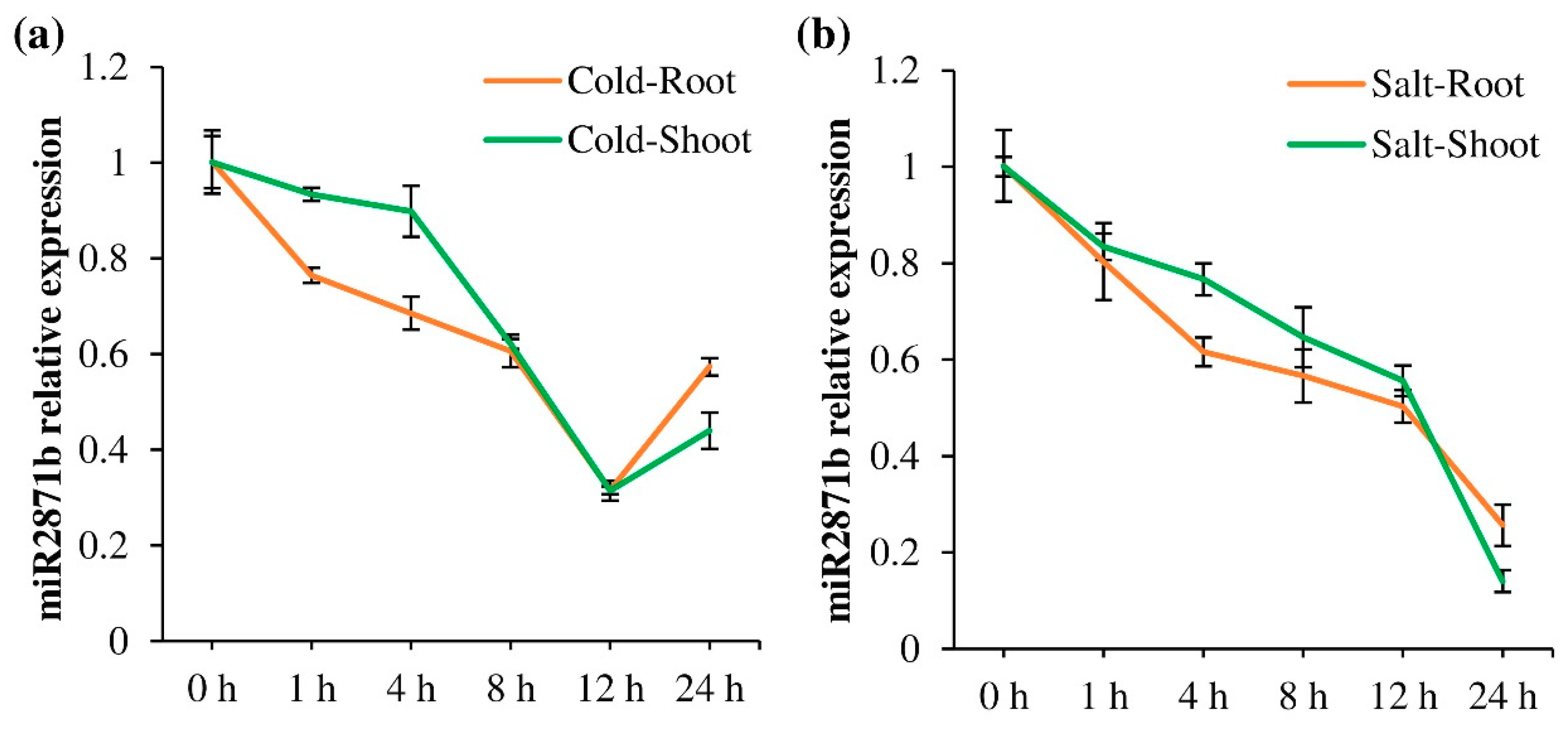


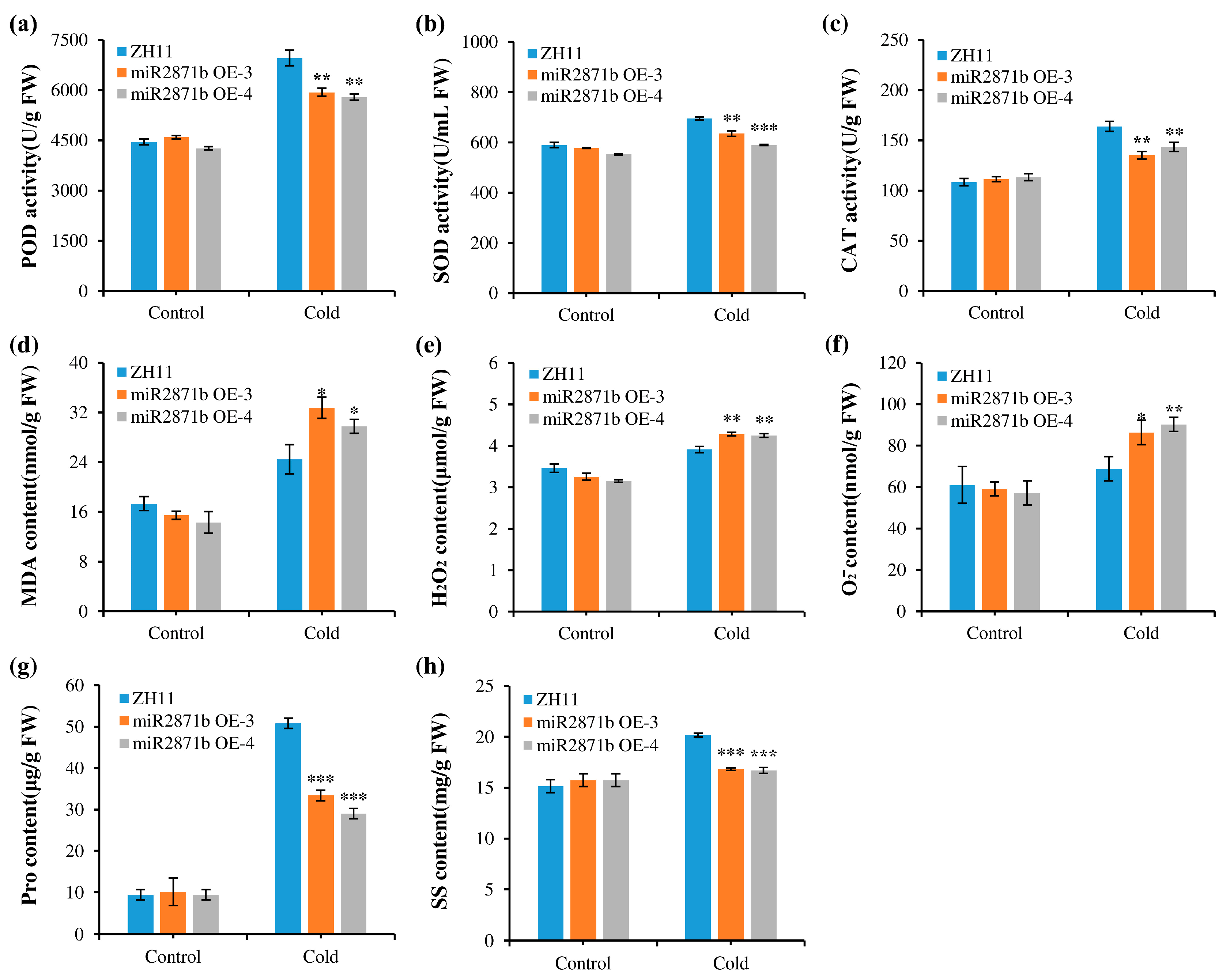
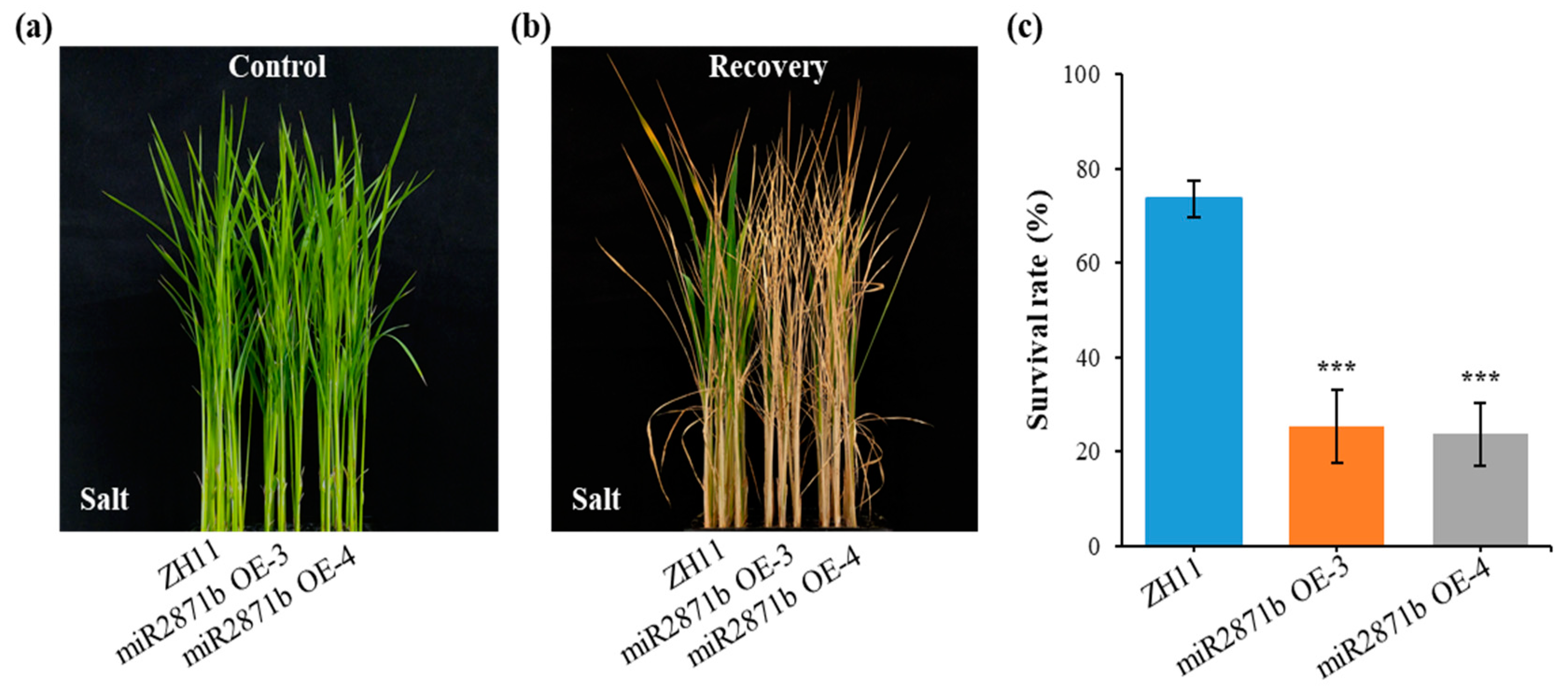
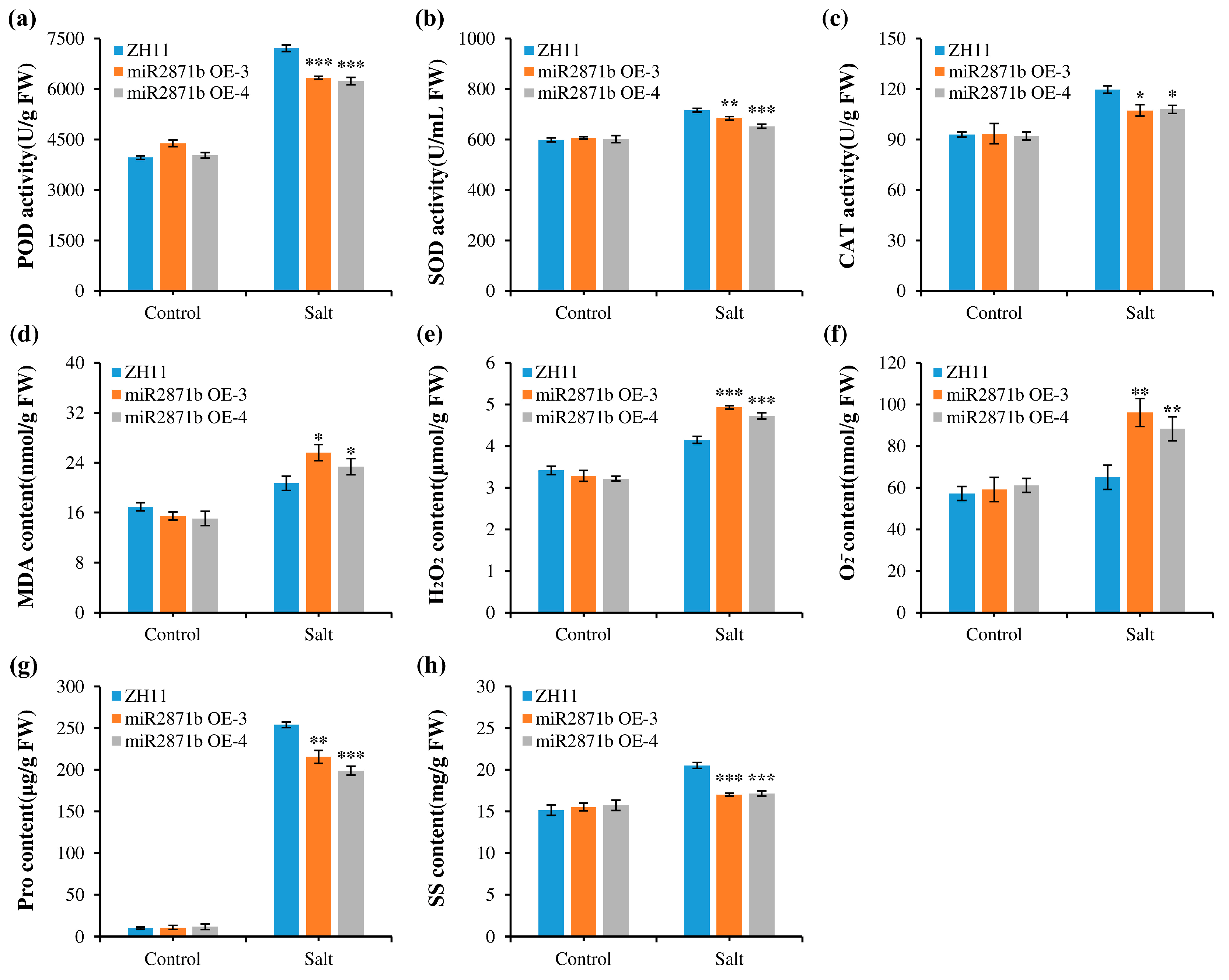
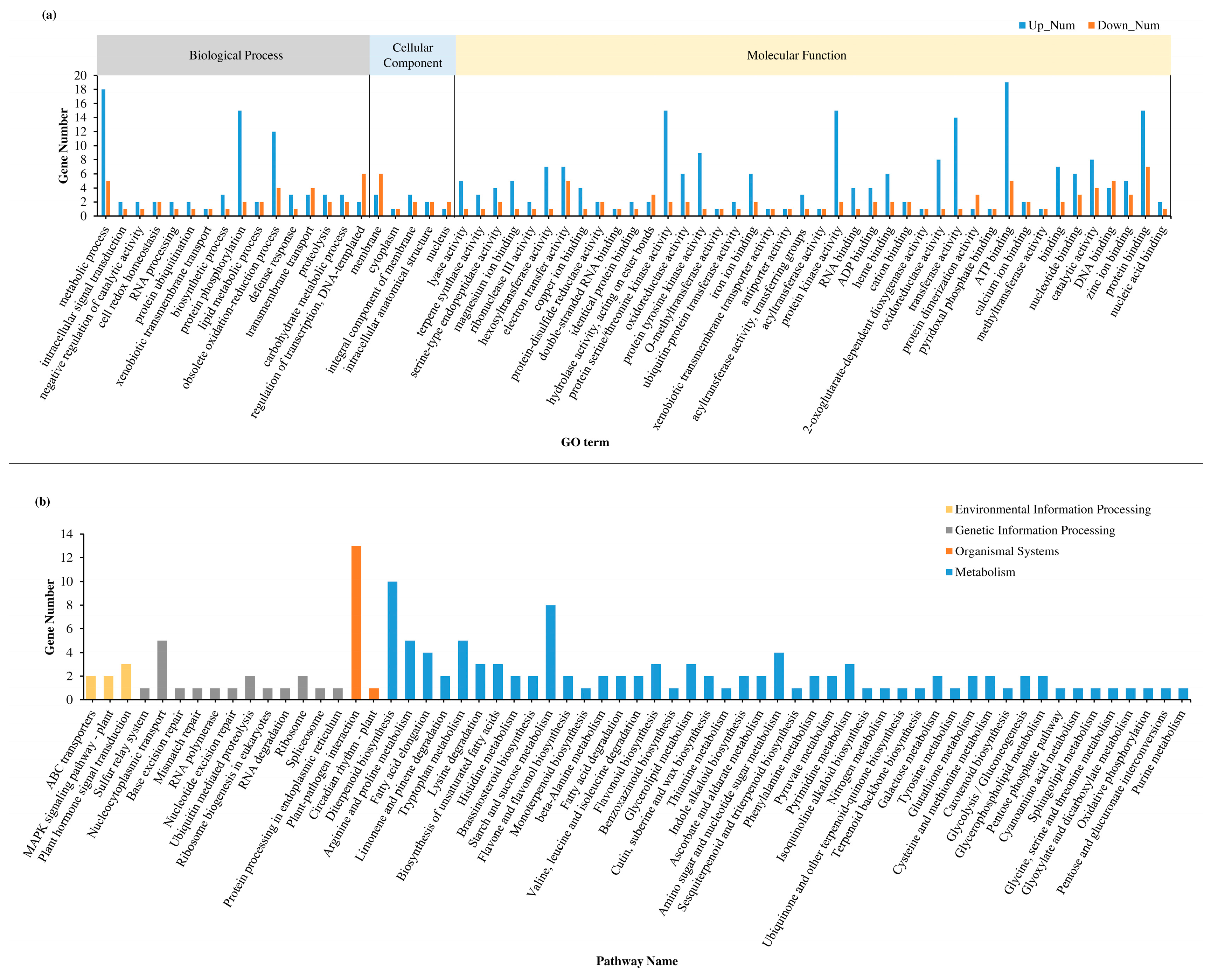
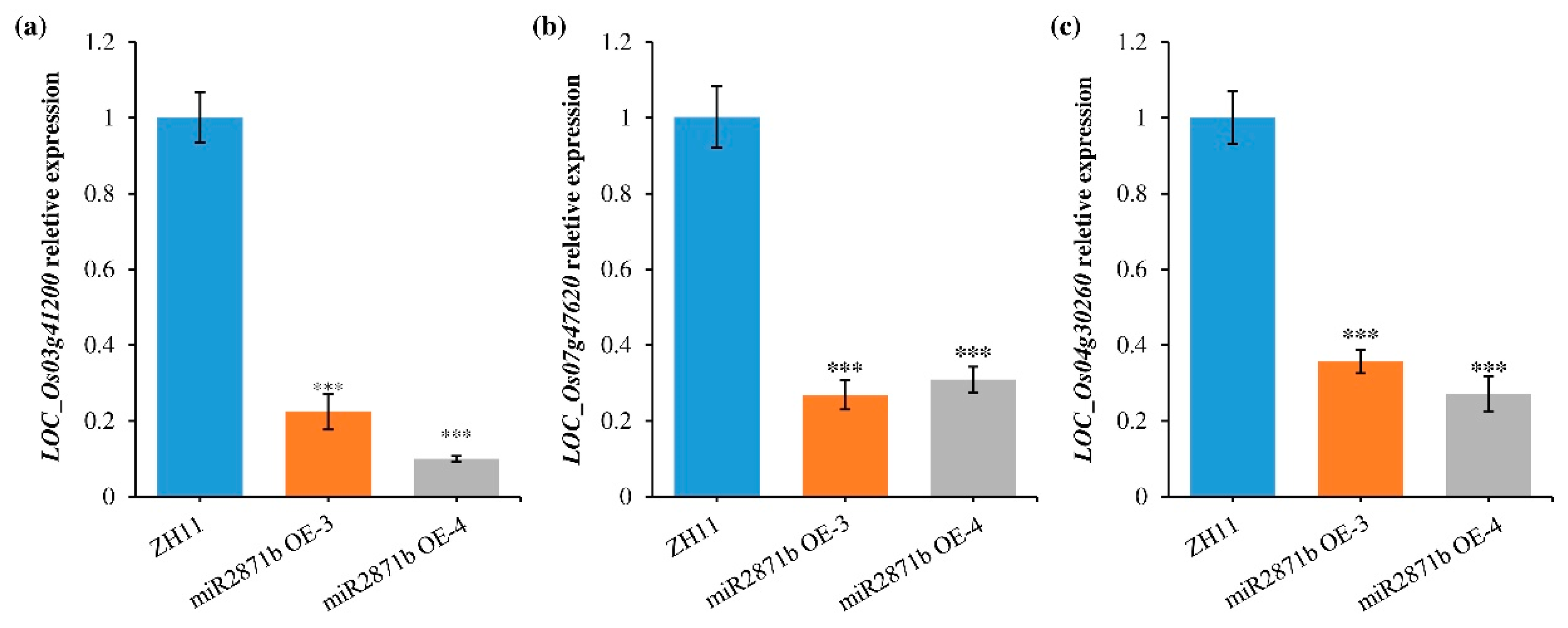
| Site Name | Loc (Strand) | Sequence | Function |
|---|---|---|---|
| ABRE | −1314 (+); −1437 (−) | ACGTG | involved in the abscisic acid responsiveness |
| Box 4 | −11 (+) | ATTAAT | part of a conserved DNA module involved in light responsiveness |
| CGTCA-motif | −702 (−); −705 (+) | CGTCA | cis-acting regulatory element involved in the MeJA-responsiveness |
| GARE-motif | −215 (+) | TCTGTTG | gibberellin-responsive element |
| G-box | −1313 (+); −1437 (+) | TACGTG; CACGTT | cis-acting regulatory element involved in light responsiveness |
| P-box | −1371 (−) | CCTTTTG | gibberellin-responsive element |
| TATC-box | −1280 (−) | TATCCCA | cis-acting element involved in gibberellin-responsiveness |
| TC-rich repeats | −369 (+) | ATTCTCTAAC | cis-acting element involved in defense and stress responsiveness |
| TGACG-motif | −702 (+); −705 (−) | TGACG | cis-acting regulatory element involved in the MeJA-responsiveness |
| TGA-element | −109 (+) | AACGAC | auxin-responsive element |
Disclaimer/Publisher’s Note: The statements, opinions and data contained in all publications are solely those of the individual author(s) and contributor(s) and not of MDPI and/or the editor(s). MDPI and/or the editor(s) disclaim responsibility for any injury to people or property resulting from any ideas, methods, instructions or products referred to in the content. |
© 2023 by the authors. Licensee MDPI, Basel, Switzerland. This article is an open access article distributed under the terms and conditions of the Creative Commons Attribution (CC BY) license (https://creativecommons.org/licenses/by/4.0/).
Share and Cite
Yang, W.; Chen, Y.; Gao, R.; Chen, Y.; Zhou, Y.; Xie, J.; Zhang, F. MicroRNA2871b of Dongxiang Wild Rice (Oryza rufipogon Griff.) Negatively Regulates Cold and Salt Stress Tolerance in Transgenic Rice Plants. Int. J. Mol. Sci. 2023, 24, 14502. https://doi.org/10.3390/ijms241914502
Yang W, Chen Y, Gao R, Chen Y, Zhou Y, Xie J, Zhang F. MicroRNA2871b of Dongxiang Wild Rice (Oryza rufipogon Griff.) Negatively Regulates Cold and Salt Stress Tolerance in Transgenic Rice Plants. International Journal of Molecular Sciences. 2023; 24(19):14502. https://doi.org/10.3390/ijms241914502
Chicago/Turabian StyleYang, Wanling, Yong Chen, Rifang Gao, Yaling Chen, Yi Zhou, Jiankun Xie, and Fantao Zhang. 2023. "MicroRNA2871b of Dongxiang Wild Rice (Oryza rufipogon Griff.) Negatively Regulates Cold and Salt Stress Tolerance in Transgenic Rice Plants" International Journal of Molecular Sciences 24, no. 19: 14502. https://doi.org/10.3390/ijms241914502
APA StyleYang, W., Chen, Y., Gao, R., Chen, Y., Zhou, Y., Xie, J., & Zhang, F. (2023). MicroRNA2871b of Dongxiang Wild Rice (Oryza rufipogon Griff.) Negatively Regulates Cold and Salt Stress Tolerance in Transgenic Rice Plants. International Journal of Molecular Sciences, 24(19), 14502. https://doi.org/10.3390/ijms241914502






